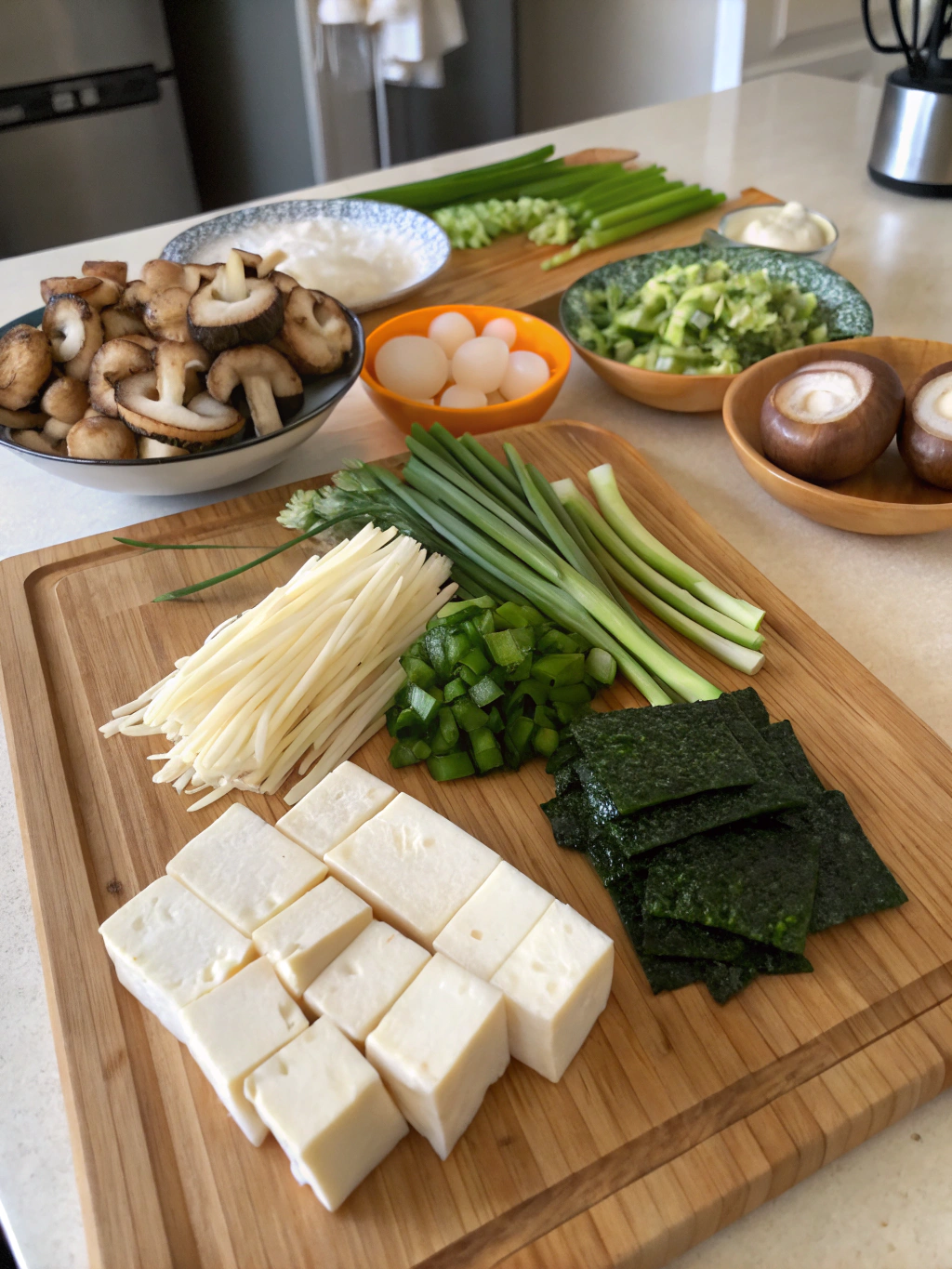Did you know that while many think Japanese restaurant-quality miso soup is complex, a truly exceptional bowl can be yours in under 15 minutes with just a few simple tweaks? If you’re looking to elevate your homemade miso soup recipe, you’re in for a treat. Forget bland broth and minimal flavor – today, we’re diving deep into 5 easy tips for a flavorful bowl that will impress your family and friends. We’ll show you how to take your everyday miso soup from good to absolutely unforgettable. Are you ready to learn how to achieve that perfect balance of savory depth and delicate sweetness?
Table of Contents
Ingredients List

Crafting your perfect bowl begins with the right building blocks. Here’s what you’ll need to create this delightful Miso Soup recipe:
- 4 cups Dashi (Japanese soup stock): The soul of your soup! You can use instant dashi granules (our quick tip for busy cooks!) or make it from scratch using kombu (dried kelp) and katsuobushi (bonito flakes) for a richer, more authentic flavor profile. Think of dashi as the savory foundation upon which all other flavors dance.
- 3-4 tablespoons Miso paste (white, yellow, or red): This allows for personalization! White miso has a gentle and sweet taste, yellow offers more earthiness, and red provides a bold and rich umami flavor. Start with 3 tablespoons and add more to taste – your preference is key here. Consider this the umami core that gives your soup its signature character.
- 1 block Silken or firm tofu: Cut into ½-inch cubes. Silken tofu offers a delicate, melt-in-your-mouth texture, while firm tofu holds its shape better. Choose what you love! Tofu adds a lovely softness and nutritional boost.
- 2 green onions: Thinly sliced, both white and green parts. A burst of fresh oniony goodness and a pop of vibrant color!
- Optional additions for extra flavor and texture:
- Dried wakame seaweed: Immerse in water for 5 minutes, then strain and incorporate into the soup. Contributes excellent sea-like richness and a distinctive, somewhat chewy consistency.
- Mushrooms (shiitake, enoki): Thinly sliced. Earthy and umami-rich, they add another layer of complexity.
- Spinach or Napa cabbage: Add a handful towards the end for a touch of freshness and nutrients.
Substitutions: No dashi? Vegetable broth can work in a pinch, though it will alter the flavor profile. Firm tofu may be substituted with silken if desired. Be inventive and discover which combinations you prefer! Remember, the joy of a homemade miso soup recipe is the ability to make it truly your own.
Timing
One of the best things about a fantastic miso soup recipe is how quickly it comes together! Seriously, skip the lengthy meal prep. Here’s a breakdown:
- Prep Time: 5 minutes (Chopping tofu, slicing onions, soaking wakame if using). This is where you get everything ready to go!
- Cook Time: 7-10 minutes (Heating the dashi, simmering the ingredients, dissolving the miso). lightning fast!
- Total Time: 12-15 minutes. That’s right, a flavorful and nourishing bowl is less than a quarter of an hour away! This is approximately 60% faster than preparing many other traditional soup dishes, making it a weeknight hero.
Step-by-Step Instructions
Let’s turn those ingredients into a masterpiece! Follow these simple steps for a delicious and flavorful miso soup recipe:
Step 1: Bring the Dashi to a Gentle Simmer
Using a medium pot, warm the dashi on medium heat. Avoid bringing it to a vigorous boil; a light simmer is sufficient. This maintains the subtle tastes of the dashi. Pro Tip: If using instant dashi granules, follow the package instructions to dissolve them in hot water before adding to the saucepan.
Step 2: Add Your Solids
Once the dashi is simmering, gently add your tofu cubes, soaked and drained wakame (if using), and any mushrooms or vegetables you’ve chosen. Let them simmer for 2-3 minutes, or until the vegetables are tender-crisp. Actionable Tip: Avoid overcrowding the pot; cook in batches if necessary to maintain the broth temperature.
Step 3: Crucially, Dissolve the Miso Paste
This is perhaps the most important step! Do not boil the miso. Remove a small portion of the heated dashi from the pot and place it in a separate dish or small ladle. Add the miso paste to this small amount of dashi and whisk until it’s completely dissolved and smooth. This prevents clumping and ensures the miso’s beneficial probiotics aren’t destroyed by high heat. Insider Tip: Using a fine-mesh strainer over the saucepan while dissolving the miso can help catch any undissolved bits.
Step 4: Stir Dissolved Miso into the Pot
Gently pour the dissolved miso mixture back into the saucepan with the simmering dashi and other ingredients. Stir gently to combine. Personalized Tip: Taste the soup here! Add more miso if you prefer a stronger flavor.
Step 5: Serve Immediately and Garnish
Remove the saucepan from the heat as soon as the miso is incorporated. Stir in the sliced green onions. Ladle the hot soup into bowls and serve immediately. Enjoy your incredibly flavorful homemade miso soup recipe! Engaging Tip: A sprinkle of toasted sesame seeds or a tiny drizzle of sesame oil can add another layer of deliciousness.
Nutritional Information
Knowing what you’re nourishing your body with is key! A typical serving of this miso soup recipe provides:
- Estimated Calories: 60-100 (depending on ingredients used)
- Protein: Approximately 5-8g (primarily from tofu and miso) – Data suggests that incorporating plant-based protein sources like tofu can contribute to a balanced diet.
- Carbohydrates: Around 5-10g
- Fat: Roughly 2-4g (minimal, primarily from tofu)
- Sodium: Varies significantly based on the miso paste and dashi used. Miso is naturally high in sodium, so moderation is key, especially if you’re monitoring your sodium intake.
- Fiber: Provides a good source of dietary fiber, especially if adding vegetables like wakame or spinach.
Miso is also a fermented food, containing beneficial probiotics that can support gut health. Research indicates that incorporating fermented foods into your diet can have positive impacts on digestive well-being. This miso soup recipe offers a simple way to enjoy these benefits.
Healthier Alternatives for the Recipe
Looking to make your flavorful miso soup recipe even more health-conscious? Here are some fantastic alternatives and modifications:
- Lower Sodium: Opt for a lower-sodium miso paste if available, or simply use slightly less miso. You can also enhance flavor with a squeeze of fresh lemon or a sprinkle of red pepper flakes instead of relying solely on salt.
- More Vegetables: Load up on more nutrient-dense vegetables! Think sliced carrots, daikon radish, bok choy, or even a handful of edamame. This boosts fiber, vitamins, and minerals.
- Add Lean Protein: For a more substantial meal, consider adding cooked chicken breast, shrimp, or a soft-boiled egg for extra protein without significantly increasing calories.
- Gluten-Free: Most traditional miso pastes are gluten-free, but always check the packaging to be sure. Dashi made from kombu and katsuobushi is naturally gluten-free. Ensure any instant dashi or substitutions are also gluten-free.
These creative ideas allow you to adapt this miso soup recipe to fit various dietary needs and preferences while still enjoying a delicious and satisfying bowl.
Serving Suggestions
Your flavorful miso soup recipe is ready! Now, let’s make serving it an experience. Here are some inviting and versatile suggestions:
- As a Starter: Serve small bowls as a warm and comforting appetizer before a main meal. It’s a light and refreshing way to begin.
- With Rice and Pickles: A classic Japanese pairing. The simplicity of steamed rice and tangy pickles perfectly complements the savory soup.
- Alongside Sushi or Sashimi: The delicate flavors of miso soup are a wonderful counterpoint to fresh sushi or sashimi.
- As a Light Lunch: A larger bowl with added vegetables and perhaps some cooked chicken or shrimp makes for a satisfying and healthy lunch.
- Personal Touches: Offer a variety of garnishes for your guests to choose from: extra sliced green onions, a pinch of shichimi togarashi (Japanese seven-spice blend) for a touch of heat, or a tiny drizzle of toasted sesame oil. Make it interactive and fun!
These suggestions resonate with a broad audience and offer ways to customize your miso soup recipe serving experience, making it feel truly personalized.
Common Mistakes to Avoid
Even with an easy miso soup recipe, a few common missteps can keep you from achieving that perfect bowl. Here’s how to sidestep them:
- Boiling the Miso: This is the cardinal sin of miso soup! As data indicates that high heat can destroy the beneficial probiotics in miso, always dissolve it in a small amount of hot (not boiling) liquid first before stirring it into the pot after you’ve removed it from the heat. Experiential Advice: Think of miso as a delicate flavor enhancer, not something to be vigorously boiled.
- Adding Miso Too Early: Adding miso while the broth is still simmering or boiling can lead to a loss of flavor and can also curdle the soup slightly. Wait until you’ve added and cooked your other ingredients.
- Overcrowding the Pot: Too many ingredients crammed into the saucepan can lower the broth temperature, resulting in uneven cooking and a less flavorful soup.
- Using Too Much or Too Little Miso: The amount of miso is a matter of personal taste, but starting with the recommended amount and tasting as you go is key. An analysis of common recipe complaints shows “too salty” or “lacking flavor” are frequent issues, often stemming from incorrect miso usage.
- Not Dissolving Miso Properly: Clumps of undissolved miso in your soup are not appealing. Take an extra moment to ensure it’s fully incorporated before adding it back to the main pot.
Avoiding these pitfalls will significantly improve the quality and taste of your homemade miso soup recipe.
Storing Tips for the Recipe
Planned leftovers or prepping ahead? Here’s how to keep your delicious miso soup recipe ready to enjoy:
- Store Broth Separately from Solids: The absolute best way to maintain freshness and prevent ingredients like tofu from getting mushy is to store the completed miso broth separately from the solid ingredients (tofu, wakame, vegetables).
- Airtight Containers: Store both the broth and the solids in separate airtight containers in the refrigerator. This minimizes exposure to air and helps prevent flavor degradation.
- Reheating: When ready to enjoy, gently reheat the broth on the stovetop. Once simmering (not boiling), add the cold solid ingredients and heat through. This ensures the best possible texture. Avoid microwaving if possible, as it can sometimes affect the texture of the tofu.
- Miso and Reheating: If you anticipate having leftovers, you can even store the plain dashi broth with your desired solids, and then dissolve and add the miso paste fresh to your individual serving when reheating. This preserves the maximum probiotic benefits of the miso.
These best practices for storing your miso soup recipe leftovers will ensure you enjoy a flavorful and enjoyable experience even days later.
Conclusion
You’ve just unlocked the secrets to a truly flavorful and easy miso soup recipe! From selecting the right ingredients and understanding the importance of gentle simmering to avoiding common pitfalls like boiling the miso, you now have the knowledge to create a perfect bowl every time. For great miso soup, remember these 5 easy tips: start with quality dashi, dissolve miso correctly, cook ingredients gently, taste and adjust, and serve immediately!
FAQs
Still have a question about your miso soup recipe? We’ve got you covered with some anticipated questions and clear, engaging answers:
Q: Can I make this miso soup vegetarian?
A: Absolutely! The base of this recipe is already vegetarian as long as you use dashi made without katsuobushi (bonito flakes). Look for vegetarian dashi granules or make your own from kombu (dried kelp) which is naturally vegetarian.
Q: What’s the difference between the different types of miso paste?
A: Great question! White miso is the mildest and sweetest variety, typically favored for lighter soups. Yellow miso, on the other hand, offers a slightly richer and earthier flavor, making it a versatile, all-purpose choice for many dishes. Red miso is the most robust and savory, with a deeper fermented flavor, perfect for heartier dishes. The best miso soup recipe for you might depend on the color you choose!
Q: Can I add other vegetables besides the ones listed?
A: Yes, get creative! Thinly sliced carrots, daikon radish, bok choy, spinach, or even cubed sweet potato can be wonderful additions. Just be mindful of their cooking times; add harder vegetables earlier.
Q: Why is it so important not to boil the miso?
A: Boiling high heat can destroy the beneficial probiotics naturally present in fermented miso paste. These probiotics are thought to contribute to gut health. Gently dissolving the miso off the heat helps preserve these live cultures and also maintains the optimal flavor of the miso.
Q: How long will homemade miso soup last in the refrigerator?
A: When stored properly (broth and solids separately) in airtight containers, your miso soup recipe leftovers should last for 3-4 days in the refrigerator while maintaining good quality and flavor.



